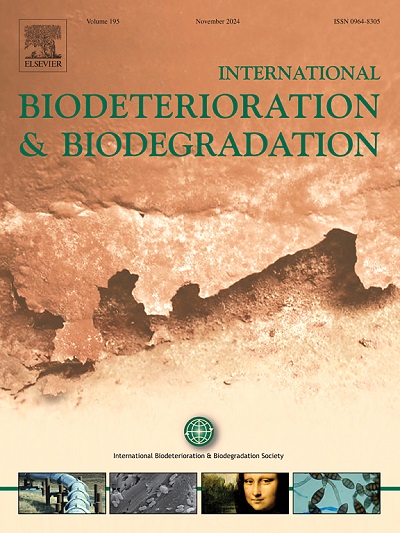环境培养的好氧颗粒污泥比实验室培养的颗粒污泥进行更完整的药物生物降解和废水处理
IF 4.1
2区 环境科学与生态学
Q2 BIOTECHNOLOGY & APPLIED MICROBIOLOGY
International Biodeterioration & Biodegradation
Pub Date : 2025-04-05
DOI:10.1016/j.ibiod.2025.106081
引用次数: 0
摘要
本研究评价了环境培养好氧颗粒污泥(AGS)对药物的去除效果。大多数药物处理研究使用实验室培养的AGS,它是从合成培养基上的活性污泥絮凝体中培养出来的,因此可能具有不同于现实世界的物理和微生物特性。用60 μg/L的吉非罗齐、双氯芬酸和红霉素的混合物饲喂环境培养AGS约70天。对废水处理、颗粒特性和药物命运进行了监测。环境培养的颗粒在多个方面都优于实验室培养的颗粒:环境颗粒在物理上不受药物的影响,磷酸盐的去除仍然完整,除氨氧化外,所有氮的去除过程都不受影响,氨氧化暂时被抑制了约35%。最重要的是,gemfibrozil被完全生物降解,这一结果尚未在任何AGS研究中观察到。双氯芬酸和红霉素的去除率很少,一般低于10%。其中,J111科、黄病菌科、OLB5科和周氏菌科被鉴定为药物降解物。结果表明,环境培养的AGS含有实验室培养颗粒中缺少的罕见但必需的微生物群落成员,这些群落增强了环境颗粒在药物暴露过程中的恢复能力。总之,这项研究表明,实验室培养的AGS可能不能准确地模拟其现实世界同类的功能能力。本文章由计算机程序翻译,如有差异,请以英文原文为准。

Environmentally-grown aerobic granular sludge performs more complete pharmaceutical biodegradation and wastewater treatment than lab-grown granules
This study evaluated pharmaceutical removal by environmentally-grown aerobic granular sludge (AGS). Most pharmaceutical treatment studies utilize lab-grown AGS, which is cultivated from activated sludge flocs on synthetic media and therefore is likely to possess different physical and microbiological properties than its real-world counterpart. For approximately 70 days, a 60 μg/L mixture of gemfibrozil, diclofenac, and erythromycin was fed to environmentally-grown AGS. Wastewater treatment, granule characteristics, and pharmaceutical fate were monitored. Environmentally-grown granules outperformed their lab-grown counterparts in multiple ways: environmental granules were physically unimpacted by pharmaceuticals, phosphate removal remained complete, and all nitrogen removal processes were unaffected except ammonia oxidation, which was temporarily inhibited by approximately 35%. Most importantly, gemfibrozil was completely biodegraded, a result yet to be observed in any AGS study. Diclofenac and erythromycin removal were minimal and generally below 10%. The families J111, Xanthomonadaceae, OLB5, and Weeksellaceae were uniquely identified as pharmaceutical degraders. Results suggest that environmentally-grown AGS contains rare, but essential, microbial community members missing from lab-grown granules, and these communities enhance environmental granules’ resilience during pharmaceutical exposure. Altogether, this study demonstrates that lab-grown AGS may not accurately model the functional capacity of its real-world counterparts.
求助全文
通过发布文献求助,成功后即可免费获取论文全文。
去求助
来源期刊
CiteScore
9.60
自引率
10.40%
发文量
107
审稿时长
21 days
期刊介绍:
International Biodeterioration and Biodegradation publishes original research papers and reviews on the biological causes of deterioration or degradation.

 求助内容:
求助内容: 应助结果提醒方式:
应助结果提醒方式:


